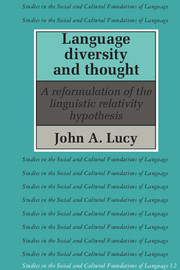Book contents
- Frontmatter
- Contents
- List of figures
- Acknowledgments
- Introduction
- 1 Development of the linguistic relativity hypothesis in America: Boas and Sapir
- 2 Development of the linguistic relativity hypothesis in America: Whorf
- 3 Approaches in anthropological linguistics: typical ethnographic case studies
- 4 Approaches in anthropological linguistics: theoretical and methodological advances
- 5 Approaches in comparative psycholinguistics: experimental studies on the lexical coding of color
- 6 Approaches in comparative psycholinguistics: experimental studies on grammatical categories
- 7 Overview and assessment of previous empirical research
- Notes
- References
- Index
3 - Approaches in anthropological linguistics: typical ethnographic case studies
Published online by Cambridge University Press: 05 June 2012
- Frontmatter
- Contents
- List of figures
- Acknowledgments
- Introduction
- 1 Development of the linguistic relativity hypothesis in America: Boas and Sapir
- 2 Development of the linguistic relativity hypothesis in America: Whorf
- 3 Approaches in anthropological linguistics: typical ethnographic case studies
- 4 Approaches in anthropological linguistics: theoretical and methodological advances
- 5 Approaches in comparative psycholinguistics: experimental studies on the lexical coding of color
- 6 Approaches in comparative psycholinguistics: experimental studies on grammatical categories
- 7 Overview and assessment of previous empirical research
- Notes
- References
- Index
Summary
Introduction
The death of Sapir in 1939 and of Whorf in 1941 in combination with the Second World War created a brief hiatus in research. Interest was revived during the post-war period sparked in part by the appearance in 1949 of a collection of Sapir's writings (Mandelbaum, 1949) and the reprinting of four of Whorf's papers on the relation of language to thought (Trager, 1950 [1949]). Throughout the 1950s and into the early 1960s the Sapir–Whorf hypothesis was a subject of active concern for a broad range of scholars and played a crucial role in the growing recognition during this period of the importance of language in human psychological and social functioning. Despite this widespread interest, a comparatively small amount of actual empirical research was undertaken. After this period, interest in the hypothesis waned with the advent of the transformational approach in linguistics with its presumptive nativism and universalism. Only within the last decade has interest in the hypothesis revived, so it is to this earlier period that we must look for much of what little empirical work exists.
Most research on the Sapir–Whorf hypothesis during this period was developed within the fields of anthropological linguistics and comparative psycholinguistics. Most of these studies take Whorf's formulations as their point of departure whether they are building on his work or being critical of it. This chapter and the next review relevant empirical studies developed within anthropological linguistics; studies within comparative psycholinguistics are taken up in two subsequent chapters.
- Type
- Chapter
- Information
- Language Diversity and ThoughtA Reformulation of the Linguistic Relativity Hypothesis, pp. 69 - 83Publisher: Cambridge University PressPrint publication year: 1992

